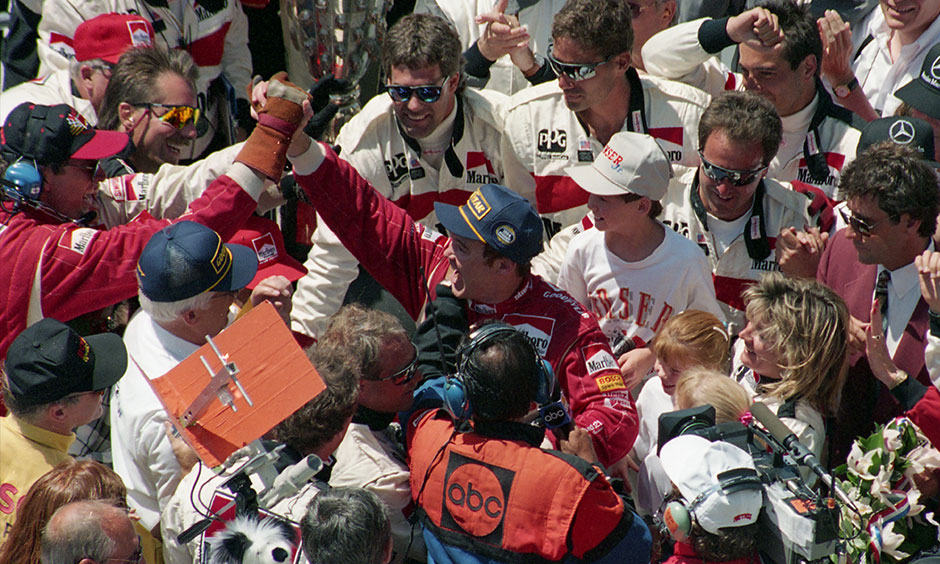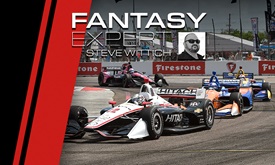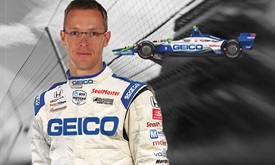Harding Steinbrenner trio recall 'Beast' of a win in 1994 Indy 500
MAY 09, 2019
The path to Al Unser Jr.’s second Indianapolis 500 victory a quarter of a century ago started out as a secret that remained unrevealed about a new powerful engine that failed repeatedly in initial tests amid freezing January temperatures on a snow-plowed Nazareth Speedway.
Many recall how that Indy 500 was won — Team Penske Emerson Fittipaldi dominated until crashing in Turn 4 on Lap 185 while trying to lap teammate Unser’s second-place car. “Little Al” cruised home to triumph in a race he thought Fittipaldi would win.
But there was so much more to the story of “The Beast,” the nickname given the Team Penske car powered by a purpose-built, 209-inch, pushrod Mercedes-Benz V-8 engine capable of generating significantly more horsepower.
Twenty-five years later, several members of that storied program can rehash its memories on a daily basis since they all work for Harding Steinbrenner Racing. Brian Barnhart, a mechanic on Unser Jr.’s Indy 500 wins in 1992 (with Galles Racing) and ’94, is now team president at HSR. Unser Jr. is the team’s executive consultant and racing coach. Doug Kissinger was a Team Penske transporter driver and race-day fueler then; he does the same at HSR now.
WATCH: 1994 Indianapolis 500 broadcast here:
Even now, Barnhart remains amazed at the power of the engine.
“Oh my God, was it a beast!” he said.
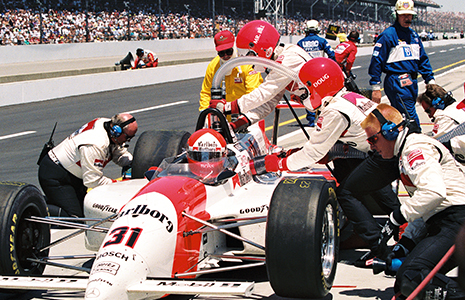 Kissinger (shown at right fueling Unser's car in 1994) was first entrusted with transporting the car shrouded in secrecy upon orders from team owner Roger Penske.
Kissinger (shown at right fueling Unser's car in 1994) was first entrusted with transporting the car shrouded in secrecy upon orders from team owner Roger Penske.
“I was the first person to pick it up when it flew over from England,” Kissinger said. “I picked it up at the airport and we drove it straight to Nazareth Speedway (in Pennsylvania) to the maintenance building.”
At that time, Penske owned the track so making it available was no issue. Problem is, the temperatures were in the 30s and there was so much snow, the track had to be plowed for testing. Paul Tracy, the third driver on the team, broke out a snowsuit.
“My first impression was it was extremely cold,” Unser said. “The inside wall was nothing but a snow bank all the way around the track.
“My first impression of the car was the torque was just incredible at such a low rpm. It was very throaty, the sound to it, and it was powerful, it was strong. But it was difficult to really tell what it was going to be at Indianapolis.
“Roger, his first question was, ‘Is it going to be a good engine for Indy?’ And I said, ‘Nazareth is too small. We can’t open it up here,’ especially for as cold as it was.”
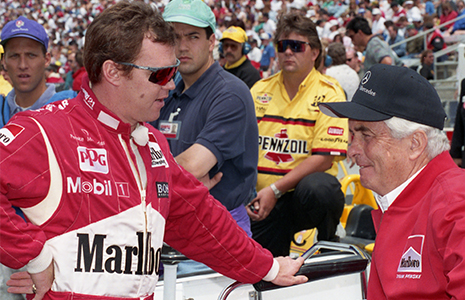 And the engine kept failing.
And the engine kept failing.
“There were times we would load it up and it would go up there and run anywhere from five to 10 miles before it would blow up,” Barnhart said. “We’d come back and they just kept fixing it. Each trip we took, it seemed to last a little longer.
“I remember even when they (filled out) entry forms for the 500, I think they (listed) the engines as TBAs.”
On the opening day of Indianapolis 500 practice, Unser’s car was elsewhere, finally proving after four months of tinkering that it could last for 500 miles during a test at Michigan International Speedway 225 miles away.
The lingering question was whether the engine would endure at IMS. There wasn’t any question about the speed.
“No one else really stood a chance if it finished,” Unser said. “That was the big thing, getting it to go the 500 miles.”
Unser caught a break in qualifying. He won the pole in cooler conditions while Fittipaldi, forced by weather to come back the second day, qualified third on a hot and humid day.
“Emerson was really the quickest all through the month,” Unser said.
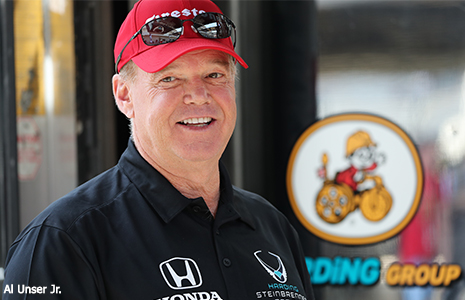 Unser led the initial race stint until making his first pit stop.
Unser led the initial race stint until making his first pit stop.
“I stalled it on my first stop, which is one of the things about the (engine) – it didn’t idle very well,” Unser said. “You had to be really careful with it pulling away from the pits. I stalled it and that’s what allowed Emerson to get the lead. Then he led for almost the whole day.”
Barnhart recalled about a third of the way through that Fittipaldi and Unser had already lapped the rest of the field.
“I guarantee you there was probably a lot of frustration from the other competitors out there with what those cars were able to do in that configuration,” Barnhart said. “They probably in some ways felt like they were taking a knife to a gun fight.”
Fittipaldi, a two-time Formula One champion who had already won the 500 in 1989 and ‘93, had Unser, Barnhart and Kissinger thinking the Brazilian was going to repeat. He led 145 laps in what would be his final Indianapolis 500.
“No, I could not beat Emerson that day. I was thinking me second and Emerson first,” Unser said with a chuckle. “Emerson was the man to beat until he made the one mistake.
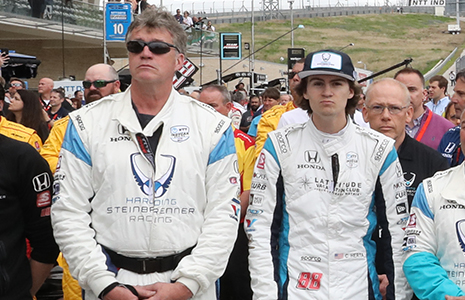 “He was coming around to lap me and I was running second. We couldn’t pass each other. We could pass all of the rest of the cars, but we couldn’t pass each other on the racetrack. He ended up trying too hard to pass me off of Turn 4 and ended up crashing.”
“He was coming around to lap me and I was running second. We couldn’t pass each other. We could pass all of the rest of the cars, but we couldn’t pass each other on the racetrack. He ended up trying too hard to pass me off of Turn 4 and ended up crashing.”
At that moment, Unser, Barnhart and Kissinger (shown at right alongside his current driver, Colton Herta) were again thinking the same thing with 15 laps to go. Please, engine, make it to the finish.
“Cross your fingers and hope it makes it to the end,” Kissinger said.
Unser had a lap lead on the field, so he let second-place Jacques Villeneuve go by to unlap himself.
“I didn’t want him making any kind of move on me,” Unser said. “I was just making sure I brought the thing home. So I let him go by me, then a yellow came out and I went, ‘Oh no, I never should have let him by me.’
“But there weren’t enough laps left in the race. We ended up going green for only a little bit, then another yellow came out and that’s how we finished, under yellow.”
It may have been a quarter of a century since that magical day, but Unser, Barnhart and Kissinger recall 1994 like it was yesterday.
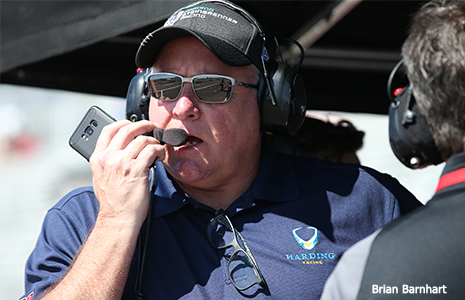 Barnhart said that win for Penske, who has now celebrated a record 17 victories in “The Greatest Spectacle in Racing,” showed how motivated the legendary owner is to finish first in this race.
Barnhart said that win for Penske, who has now celebrated a record 17 victories in “The Greatest Spectacle in Racing,” showed how motivated the legendary owner is to finish first in this race.
“He lives every day of his life, in terms of racing, thinking about how he can improve his chances of winning another Indianapolis 500,” Barnhart said.
Rule changes the next season eliminated the advantages of the pushrod engine, which didn’t return.
Unser won eight of 16 races in 1994 to capture his second and final Indy car season championship. But as he always reminds, it’s the Indy 500 triumphs that matter the most.
But when did he truly know he had his 1994 win?
“When I crossed the finish line,” Unser said. “You never know about anything at the Indy 500 until the checkered flag. Even on the very last lap, I was praying and praying that the thing stayed running for that last lap.”











